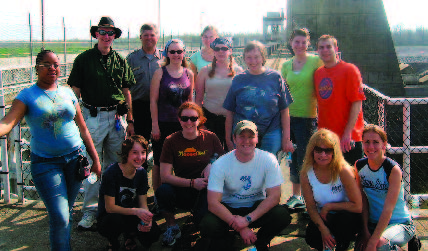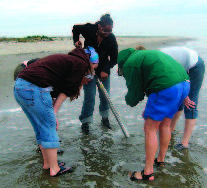WSU geology students leads post-Katrina delta field trip

Eighteen months after Hurricane Katrina devastated the City of New Orleans, a group of WSU undergraduate environmental science and geology students traveled to the Mississippi River Delta during their 2007 spring break.
The journey was the latest in a series of annual field trips organized by the Department of Geology to explore environmental, ecological, and economic places of interest across the United States.
Recent destinations have included the San Andreas Fault (2003), the Mississippi River Delta (2004), the Grand Canyon (2005), and the West Texas Permian Reef (2006). The objective of the 2007 trip was to observe Katrina's lingering impact on deltaic landforms, ecosystems, and the engineering structures designed to protect the city from floods and hurricanes.
The field trip was organized by WSU Professor Lawrence D. Lemke, who holds a Ph.D. in environmental engineering. Dr. Lemke lived in New Orleans for three years during his twelve-year career as a petroleum geologist with Exxon and its worldwide affiliates. Drawing on his personal experience, Dr. Lemke arranged for the students to tour the city in areas that were most affected by Hurricane Katrina. These included neighborhoods adjacent to levee breaks in the Lower 9th Ward and along the London Avenue and 17th Street Canals.
 Students viewed the foundations of houses that had been washed away by the force of the floodwaters; peered into homes that were buried in mud and sand; and examined repairs and improvements that subsequently have been completed along with the levee breaks. "It was quite amazing to see what happened there with my own eyes. It is one thing to watch it on TV and quite another to see it in person," said WSU environmental science major Rebecca Jackson.
Students viewed the foundations of houses that had been washed away by the force of the floodwaters; peered into homes that were buried in mud and sand; and examined repairs and improvements that subsequently have been completed along with the levee breaks. "It was quite amazing to see what happened there with my own eyes. It is one thing to watch it on TV and quite another to see it in person," said WSU environmental science major Rebecca Jackson.
Dr. Stephen Nelson from Tulane University joined the group for a day to explain how the geology of the underlying sediments contributed to the levee failures. Dr. Nelson's research suggests that the movement of water through permeable soil units beneath the floodwalls and their underlying sheet pilings undermined portions of the levees and caused them to give way. WSU environmental science major Tanya Martin observed, "The trip contributed to my understanding of the levee system because prior to the trip I had only seen pictures. It also made me think that there is a constant struggle between man and nature when trying to live in a city that is below sea level."
The group then spent several days exploring marine, brackish, and freshwater ecosystems (barrier islands, bays, and marshes) in southern Louisiana on boats provided by the Louisiana Universities Marine Consortium (LUMCON) and the U.S. Army Corps of Engineers (USACE). According to Dr. Lemke, "It readily became apparent to all of us on the trip that the sustainable habitation of New Orleans is intimately linked to the preservation of the deltaic wetlands that fuel the economy and provide the cultural identity of the surrounding region.
Unfortunately, subsidence and erosion are causing these wetlands to disappear at an alarming rate." Many in the region point to the levee system built to protect residents from the floodwaters of the Mississippi River as the culprit. With more than 960 miles of continuous levees in the New Orleans District alone, the river and its distributaries can no longer replenish the sediment needed to sustain the wetlands when the river rises to its natural flood stage. Consequently, modern delta management practices are beginning to include engineered breaks in the levees to allow fresh water and sediment back into the coastal wetlands.
While in southern Louisiana, the WSU group was able to tour three USACE facilities along the Lower Mississippi River. These included the Old River Control Structure, the Davis Pond Freshwater Diversion Project, and the Bonnet Carré Spillway. Many of the students read "The Control of Nature" by John McPhee to better understand USACE efforts to prevent the Atchafalaya River from capturing and redirecting the Mississippi at Old River, 300 miles above the present-day Mississippi River mouth. Should the Atchafalaya win this battle, there will be enormous economic consequences for Baton Rouge, New Orleans, and the industrial complex along the Mississippi River in between the two cities.
The Davis Pond Project is a recently completed opening in the Mississippi River levee that diverts water into adjacent wetlands and is helping to restore valuable marsh habitat. The Bonnet Carré Spillway is another engineered break in the levee that was constructed shortly after the catastrophic floods of 1927 to protect New Orleans from high Mississippi River waters. It has been opened only eight times since then, allowing floodwaters to spill out into Lake Pontchartrain north of the city. Today, Bonnet Carré is being considered as a possible additional freshwater diversion project.
These stops gave the WSU geology and environmental science students on the trip time to consider how human activities and natural processes compete to shape the river, delta, and coastal wetlands of southern Louisiana. "I learned so much about how the amount of sediment that water carries has such an enormous effect on the ability of a coastal region to be restored.
It readily became apparent to all of us on the trip that the sustainable habitation of New Orleans is intimately linked to the preservation of the deltaic wetlands that fuel the economy and provide the cultural identity of the surrounding region. Unfortunately, subsidence and erosion are causing these wetlands to disappear at an alarming rate.
Lawrence Lemke
I now understand what actually happened with Hurricane Katrina and its effects on the geology of that area, and the many social and political problems New Orleans still faces today. I absolutely loved this trip," said Karen Van Tiem, a freshman geology major. Joe Bader, a junior majoring in geology, added, "You cannot form original ideas and make interpretations without first-hand experience. This was an excellent way to add to the mental warehouse of information I will use to help make future decisions and interpretations."
The trip also gave the student participants a chance to reflect on possible career paths. Shannon Molaroni, a senior with a dual major in geology and environmental science, explained that the trip "definitely added to my interest in graduate research, and has further demonstrated the correlation between geology and ecology, which is where I would like to find my niche." Similarly, Rebecca Jackson remarked, "This trip has shown me that I really want to pursue a career in aquatic ecology/conservation. From there we will see. I do know that I can definitely see myself spending my days on a research boat." One thing seems certain, however. Field trips such as these provide Wayne State University students with a valuable opportunity to study environmental science and geology in the real world.